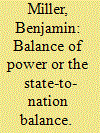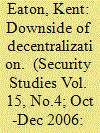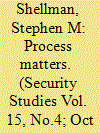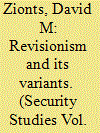|
|
|
Sort Order |
|
|
|
Items / Page
|
|
|
|
|
|
|
| Srl | Item |
| 1 |
ID:
077743


|
|
|
|
|
| Publication |
2006.
|
| Summary/Abstract |
The Middle East is one of the most war-prone regions in the international system. What is the most powerful explanation of the war-propensity of this region? I argue that neither realism nor liberalism are able to account for variations in regional war-proneness. Instead, I advance an alternative explanation based on the concept of the state-to-nation balance in the region. This balance refers to the degree of congruence between the division of the region into territorial states and the national aspirations and political identifications of the region's peoples. The balance also refers to the prevalence of strong versus weak states in the region. Thus, I explain the Middle East's high war-proneness by focusing on its relatively low level of state-to-nation balance. This imbalance has led to a powerful combination of revisionist ideologies and state incoherence. While other regions suffer from state incoherence, powerful revisionist nationalist forces, notably pan-nationalist and irredentists (the "Greater State"), aggravate this problem in the Middle East. These revisionist forces are often transborder and are especially powerful in the Middle East because of the high degree of external/transborder incongruence in comparison with all other regions. The combination of nationalist revisionism and state incoherence has made the Middle East more prone to violence than most other regions
|
|
|
|
|
|
|
|
|
|
|
|
|
|
|
|
| 2 |
ID:
077739


|
|
|
|
|
| Publication |
2006.
|
| Summary/Abstract |
In recent years, decentralization and regional autonomy measures have figured prominently in negotiations designed to end some of the world's most important conflicts, including in Afghanistan, Iraq, and Sudan. Reforms that shift powers to subnational units deserve the attention of those who are trying to promote security via institutional design, but the risks associated with these territorial reforms are considerable. When political and economic resources are transferred to subnational governments in the attempt to create meaningful access to the political system for former combatants, the great risk is that these same resources can be used to finance a continuation of the armed struggle instead. In response to the popularity of territorial reforms in many post-conflict settings, this paper sounds a cautionary note by evaluating the negative impact of decentralization on security in Colombia, site of Latin America's longest and deadliest armed conflict. After analyzing the design decisions of reformers who hoped that decentralization would help end the conflict, I argue that decentralization in fact financed the expansion of armed clientelism by illegal groups on both the left and right. Thanks to the weakness of the police in much of the national territory, guerrillas and paramilitaries have been able to use decentralized resources to destabilize the state, limiting even further its monopoly over the use of force and creating what are in effect parallel states on the left and right
|
|
|
|
|
|
|
|
|
|
|
|
|
|
|
|
| 3 |
ID:
077740


|
|
|
|
|
| Publication |
2006.
|
| Summary/Abstract |
Competing hypotheses on the relationship between government and dissident behavior emerge from both formal and empirical models. Yet, the current literature lacks a comprehensive theoretical account of such contradictory effects. This study develops a theory to account for a large number of competing hypotheses within a single framework. The theory explains various government and dissident tactical choices over the course of an internal political struggle by focusing on leaders, their motivations, and the link between their motivations and actions. The theory gives rise to a process model of sequential government-dissident interactions that is used to test several implied hypotheses. Empirical sequential time-series models of government and dissident behavior find support for most of the theory's implied hypotheses in Israel (1979-2002) and Afghanistan (1990-99).
|
|
|
|
|
|
|
|
|
|
|
|
|
|
|
|
| 4 |
ID:
077742


|
|
|
|
|
| Publication |
2006.
|
| Summary/Abstract |
States respond to failure in different ways. In light of the phenomenon of revisionist states, it is particularly important to understand why some revisionist states revert to status quo pursuits in the face of policy failure, while others pursue revisionism even in the face of external developments that we might expect would push them toward moderation. Domestic structure, domestic politics, and elite ideology each contribute to an explanation of how revisionist states respond to policy failure, but none of these variables alone tells the full story. As is illustrated through case studies of Iranian, Israeli, and Iraqi foreign policy in the 1980s, domestic structure plays the launching role in the analysis of how a revisionist state will behave. Regime type structures the incentives facing leaders and determines whether domestic politics or elite ideology is determinative in predicting a revisionist state's reactions to failure
|
|
|
|
|
|
|
|
|
|
|
|
|
|
|
|
| 5 |
ID:
077741


|
|
|
|
|
| Publication |
2006.
|
| Summary/Abstract |
The India-Pakistan conflict is one of the most enduring rivalries of the post-World War era. Thus far, it has witnessed four wars and a number of serious interstate crises. The literature on enduring rivalries suggests that the India-Pakistan dyad contains factors such as unsettled territorial issues, political incompatibility, irreconcilable positions on national identity, and the absence of significant economic and trade relations between the two states, all cause the rivalry to persist. In this article I present a crucial neglected structural factor that explains the endurance of the rivalry. I argue that the peculiar power asymmetry that has prevailed between the two antagonists for over half a century has made full termination of the rivalry difficult in the near-term. Truncated power asymmetry is a causal factor in this rivalry's persistence, as rivalries between a status quo power and a challenger state that are relatively equal in their capabilities at the local level are the most intractable and nearly impossible to resolve quickly. The duration of many other asymmetric rivalries can also be explained using a framework of global superiority versus local parity in power capabilities that exist between the antagonists
|
|
|
|
|
|
|
|
|
|
|
|
|
|
|
|
|
|
|
|
|